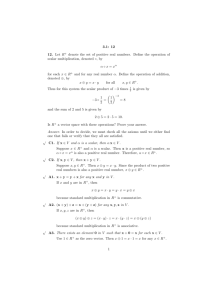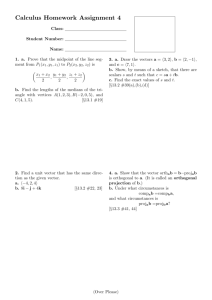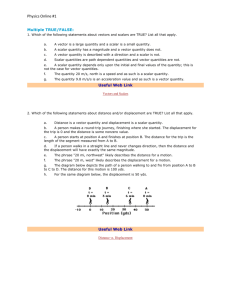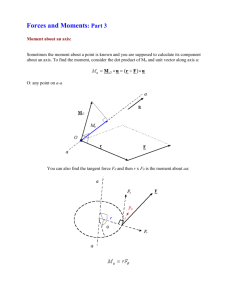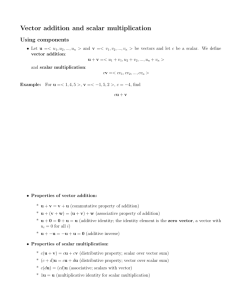Exercise 7.5
advertisement
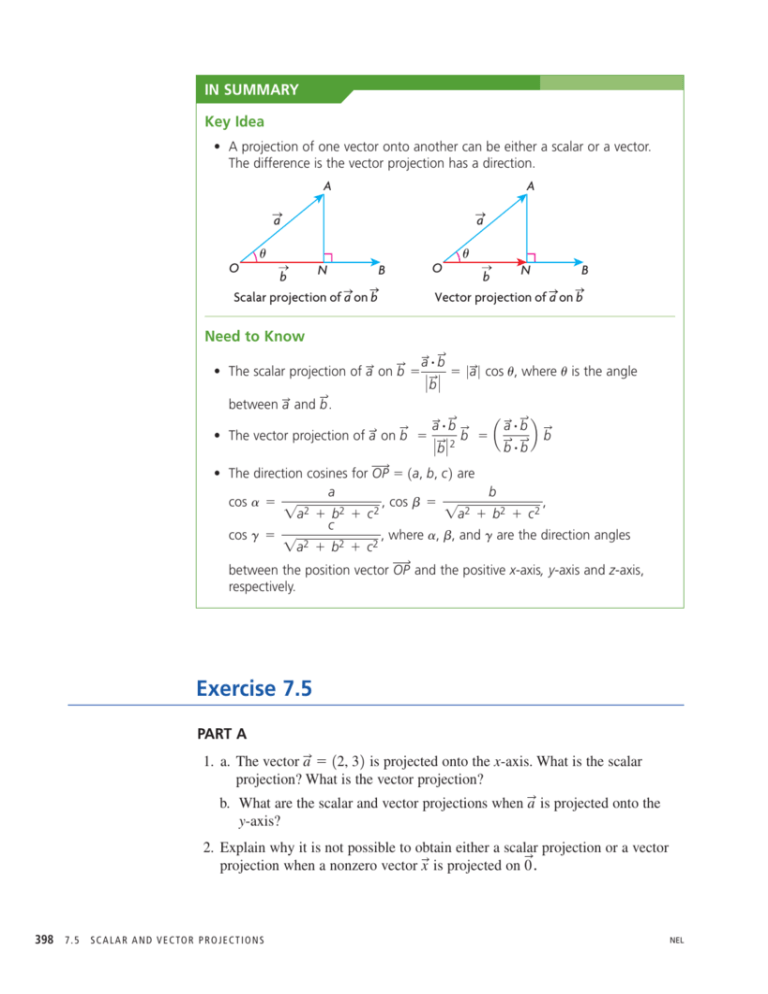
IN SUMMARY Key Idea • A projection of one vector onto another can be either a scalar or a vector. The difference is the vector projection has a direction. A A a a O u N b Scalar projection of a on b B O u b N B Vector projection of a on b Need to Know ! ! a! # b ! ! • The scalar projection of a on b ! 0 a 0 cos u, where u is the angle @b@ ! ! between a and b . ! ! ! ! ! ! a#b ! a#b ! • The vector projection of a on b ! b a ! ! b b b#b @b@2 ! • The direction cosines for OP 1a, b, c2 are a b cos a , cos b , Va2 b2 c 2 Va2 b2 c 2 c cos g , where a, b, and g are the direction angles Va2 b2 c2 ! between the position vector OP and the positive x-axis, y-axis and z-axis, respectively. Exercise 7.5 PART A ! 1. a. The vector a 12, 32 is projected onto the x-axis. What is the scalar projection? What is the vector projection? ! b. What are the scalar and vector projections when a is projected onto the y-axis? 2. Explain why it is not possible to obtain either a scalar ! projection or a vector ! projection when a nonzero vector x is projected on 0 . 398 7 . 5 S C A L A R A N D V E C TO R P R O J E C T I O N S NEL ! ! 3. Consider two nonzero vectors, a and b , that are perpendicular to each other. ! ! ! Explain why the scalar and vector projections of a on b must be 0 and , 0 ! ! respectively. What are the scalar and vector projections of b on a ? ! ! ! ! 4. Draw two vectors, p and q . Draw the scalar and vector projections of p on q . Show, using your diagram, that these projections are not necessarily the same ! ! as the scalar and vector projections of q on p . 5. Using! the formulas in this !section, determine the scalar and vector projections ! ! of OP 11, 2, 5 2 on i , j , and k . Explain how you could have arrived at the same answer without having to use the formulas. PART B ! ! 6. a. For the vectors p 13, 6, 222 and q 14, 5, 20 2 , determine the ! ! scalar and vector projections of p on q . ! b. Determine the direction angles for p . K 7. For each of the following, determine the scalar and vector projections of ! ! x on y . a. x 11, 12 , y 11, 12 ! ! b. x 12, 2兹3 2 , y 11, 02 ! ! c. x 12, 52 , y 15, 12 2 ! ! ! 8. a. Determine the scalar and vector projections of a 11, 2, 42 on each of the three axes. C b. What are the scalar and vector projections of m11, 2, 42 on each of the three axes? ! ! 9. a. Given the vector a , show with a diagram that the vector projection of a on ! ! ! ! ! a is a and that the scalar projection of a on a is 0a 0 . b. Using the formulas for scalar and vector projections, explain why the results in part a. are correct if we use u 0° for the angle between the two vectors. ! ! ! 10. a. Using a diagram, show that the vector projection of a on a is a . A NEL b. Using the formula for determining scalar projections, show that the result in part a. is true. ! 11. a. Find the scalar and vector projections of AB along each of the axes if A has coordinates 11, 2, 2 2 and B has coordinates 11, 3, 42 . ! b. What angle does AB make with the y-axis? CHAPTER 7 399 C B a u b u c ! ! 12. In the diagram shown, ^ ABC is an isosceles triangle where 0a 0 @ b @ . ! ! a. Draw the scalar projection of a on c . A b. Relocate b!, and draw the scalar projection of b! on c!. ! ! c. Explain why the projection of a on c is the same as the scalar ! scalar ! projection of b on c . ! ! ! ! d. Does the vector projection of a on c equal the vector projection of b on c ? ! ! ! ! 13. Vectors a and b are such that 0a 0 10 and @ b @ 12, and the angle between them is 135°. ! ! a b a. Show that the scalar projection of on does not equal the scalar ! ! projection of b on a . b. Draw diagrams to illustrate the corresponding vector projections associated with part a. ! 14. You are given the vector OD 11, 2, 2 2 and the three points, A12, 1, 4 2 , B11, 3, 32 , and C16, 7, 5 2 . ! ! a. Calculate the scalar projection of AB on OD . ! ! b. Verify computationally that the ! scalar! projection of AB on OD added to the ! scalar ! projection of BC on OD equals the scalar projection of AC on OD . T c. Explain why this same result is also true for the corresponding vector projections. ! 15. a. If a, b, and g represent the direction angles for vector OP , prove that cos2 a cos2 b cos2 g 1. ! b. Determine the coordinates of a vector OP that makes an angle of 30° with the y-axis, 60° with the z-axis, and 90° with the x-axis. c. In Example 3, it was shown that, in general, the direction angles do not always add to 180°—that is, a b g 180°. Under what conditions, however, must the direction angles always add to 180°? PART C 16. A vector in R 3 makes equal angles with the coordinate axes. Determine the size of each of these angles if the angles are a. acute b. obtuse ! 17. If a, b, and g represent the direction angles for vector OP , prove that sin2 a sin2 b sin2 g 2. ! ! 18. Vectors OA and OB are not collinear. The sum of the direction angles of each vector is 180°. Draw diagrams to illustrate possible positions of points A and B. 400 7 . 5 S C A L A R A N D V E C TO R P R O J E C T I O N S NEL
